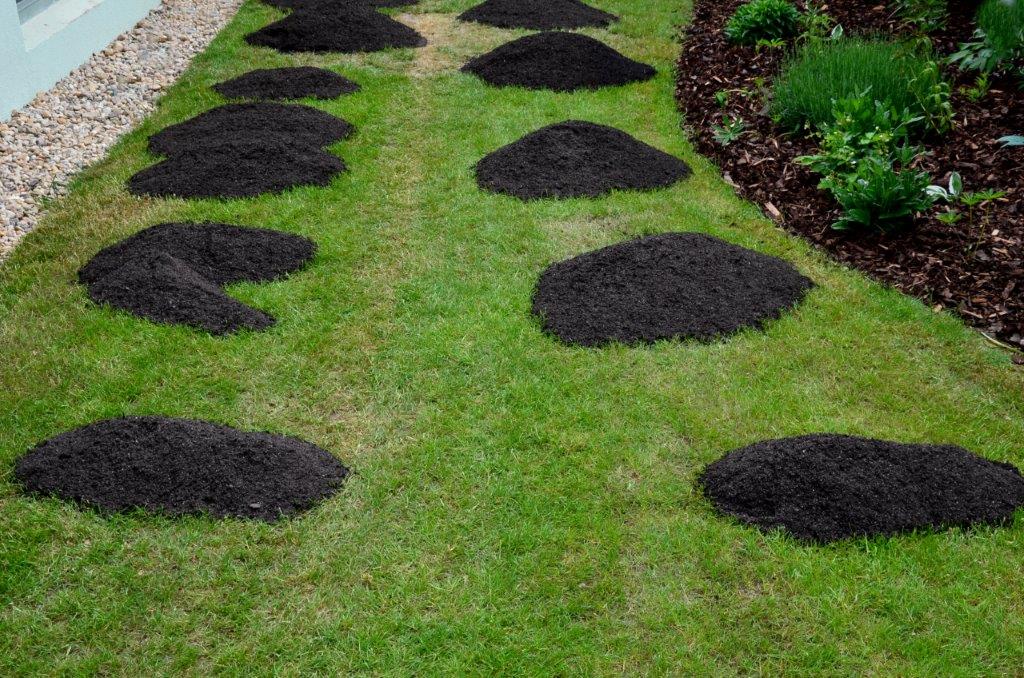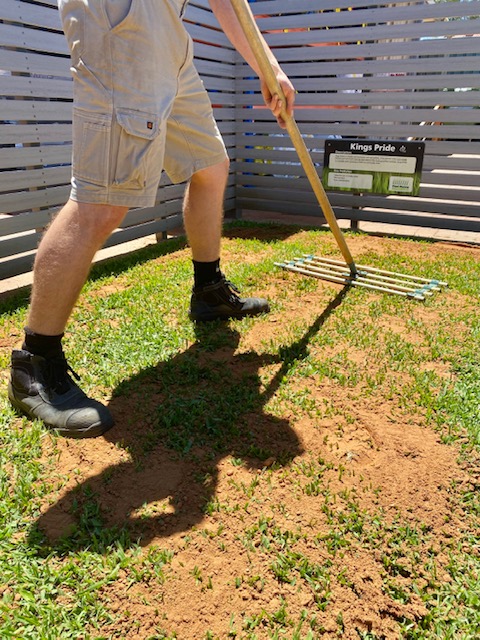Top Dressing a Lawn
Author: Stefan Palm Date Posted: 7 November 2024
Top dressing a lawn is usually done to level up an uneven surface or to fill in holes however there are some other advantages that you may not be aware of. Find out more about the benefits and how it do it yourself.
This simple yet powerful lawn maintenance task involves applying a thin layer of sand and organic matter over the grass, and its benefits are far-reaching. Let's delve into the numerous advantages of top-dressing your lawn.
Enhanced Soil Structure
Top dressing helps improve the overall structure of your soil. Over time, lawns can suffer from soil compaction due to foot traffic, heavy machinery, or natural settling. This compaction limits root growth and hinders water infiltration. Top dressing with a mix of organic matter and soil amendments enhances soil aeration and drainage, promoting healthier root systems and nutrient absorption.
Nutrient Enrichment
Your lawn, like any living organism, requires essential nutrients to thrive. Top dressing provides an opportunity to introduce valuable nutrients into the soil. By choosing a high-quality compost or specialized top dressing mix, you can replenish depleted nutrients and create a fertile environment for grass growth. This results in a greener, more resilient lawn.
Improved Moisture Retention
With South Australia's temperate climate, water conservation is crucial. Top dressing acts as a natural moisture retainer, preventing excessive evaporation and runoff. The added organic matter in the top dressing mix acts like a sponge, holding moisture in the soil and making it more available to the grass roots. This can be especially beneficial during hot and dry periods, reducing the need for frequent irrigation.
Leveling Uneven Surfaces
Lawns often develop uneven surfaces due to factors such as settling, animal activity, or the growth and decay of tree roots. Top dressing with a levelling mix helps smooth out these irregularities, providing a more even and aesthetically pleasing lawn surface. This not only enhances the visual appeal but also makes mowing and other maintenance tasks more straightforward.
What sort of material is best?
A top dressing mix can consist of a combination of sand, loam and compost. If you’re not looking to level up your lawn, then simply use compost. Make sure you buy one that has been properly made and highly composted. If you’re looking to fill in low spots, then you’ll need to use sand or sandy loam. In this case, it’s important to make sure that the texture of the sand and loam you use matches the soil under the lawn as closely as possible, as these new materials will eventually form part of the root zone and will therefore, need to blend well. Sand or sandy loam is sometimes used as a topdressing material on lawns with heavy clay soils or drainage problems. Usually applied after aerating, the sand fills in the holes and, over time, can alter the structure of the soil to allow for better drainage and healthier grass. You can buy top dressing mix in bags from us and most hardware stores. Check with your local landscape supply yard for bulk quantities.
DIY Top Dressing
Start by mowing your lawn. This will make spreading the top dressing material across the lawn easier and will facilitate keeping the top dressing layer as thin as possible.

If you’re top dressing simply for the health benefits rather than to level your lawn, a light layer of around 3 -5 mm is what you are looking for. A 20kg bag of top dressing mix would be enough for about 3-5 square metres. If you’re topdressing to level your lawn up, it’s best to keep the depth of top dressing at no more than 10mm. If you have holes that are deeper than 10mm, you’ll have to top dress in stages, letting your lawn recover between applications.
Spread the top dressing material in small piles around your lawn and rake them in evenly using the back edge of a rake, or even better, get your hands on a levelling rake like the one pictured here. Once finished, you should see the tips of the lawn poking through the top dressing. Avoid completely burying the lawn, as this will result in it taking longer to recover. If you haven’t fertilised in a while, now is the time to do it. The last step is to water the top dressing into the lawn. This will help settle it down into the thatch layer.
When do you top-dress?
The best time of year to top dress is from October through to March. You need a good 4 - 6 weeks of warm weather for your lawn to grow through. When top dressing for levelling purposes, you only need to do that as required. Top dressing with compost can be done every year for good soil and turf health.
Comments (10)
yard cleanups near me
By: yard cleanups near me on 6 May 2025This guide to top dressing is super helpful—your explanation of when and how to do it really clears up the confusion I had. I appreciate the practical tips, especially about choosing the right soil mix. It also reminded me how important a good clean slate is, and searching “<a href="http://paradisescapes.com">yard cleanups near me</a>” could be a great first step before starting the process. Thanks again for such an informative post!
Time of year to top dress
By: Dave on 16 March 2025Hi, I live on the southern tip of western Australia and have the good old Aussie Kikuyu grass. In summer everyone’s including mine, grass browns and grows like a champion through winter. Should I follow the guide of Oct-March for top dressing or should I turn the tables on that? I was thinking April before we get a bit more rain. What are your thoughts based on this region.
Paul Munns Instant Lawn Response
Hi Dave, as a general rule we would recommend sticking with October-March for top-dressing. You'll want to give your kikuyu a good 4-6 weeks' worth of warm weather to grow through the soil/compost you apply. Having said that, there may be weather differences between us in SA and yourself in WA that could change this advice. If you're unsure, I'd recommend consulting a garden centre in WA. Thanks for your enquiry!
Repair lawn
By: Ian Dunham on 15 January 2025Hi I have a rye Kentucky Bluegrass Lawn from seed 12 months old. Unfortunately we had a lot of Weeds in the Lawn and I have dug the weeds out consequently leaving large holes in the lawn. The lawn is sitting on clay 4 inches of topsoil. What would you suggest I do to even the Lawn out? You saying to fill the holes or do a complete top dress with organic soil and Overseas thank you looking forward to your response.
Paul Munns Instant Lawn Response
Hi Ian, I would be inclined to just fill the holes with sandy loam and re seed in those spots. Hope that helps and thanks for your enquiry
Applying gypsum to lawn on clay soil
By: Liz on 8 December 2024I have a patchy lawn on hard clay soil that I would like to try to revive, rather than starting from scratch. Would it be a good idea to water in some gypsum before topdressing? And should I soak the area first to soften the clay, then aerate it?
Paul Munns Instant Lawn Response
Hi Liz, I wouldn't be able to advise on how reviving your specific lawn will go with the current soil, however, it is definitely possible to grow a healthy lawn on a clay soil! Aerating a clay soil at this time of year can be difficult, as the heat can cause them to harden. Usually coring is best done in August/September when soils are still soft from the winter rains, but you could try soaking the area first. Try to do this in advance to avoid coring mud. I would recommend applying gypsum after aerating, as it will be able to penetrate deeper into the soil via the cored holes. For further advice, please give us a call on 8298 0555. Thanks for your enquiry!
Qld Top dressing Santa Ana - Wet or Dry?
By: Marilyn on 16 October 2024Hello I have purchased the top dressing, unfortunately when delivered, the rain had arrived. It has rained for more than 30 hours intermittently, how dry does the lawn need to be before spreading can happen? Thank you.
Paul Munns Instant Lawn Response
Hi Marilyn, you can top dress after the rain, however it's much easier to distribute the sandy loam when both the lawn and soil are dry. Sandy loam tends to form lumps when applied wet, so you'll get a more even application if you're able to wait for some dry weather. Thanks for your enquiry.
Sandy soil and unhappy lawn
By: Chris on 3 August 2024My front yard lawn is not looking all that great, not much green growth whereas my backyard is happy, healthy and enjoys a regular mow. I’ve dug into the soil and it’s very sand with minimal soil. I believe my grass is a buffalo or kikuyu variety. Will adding a layer of soil help here and can I do it at this time of year?
Paul Munns Instant Lawn Response
Hi Chris, Unfortunately this time of year there isn't a lot you can do to improve your lawn and applying top soil isn't going to help either. Once the weather improves and your lawn comes out of dormancy is the time to top dress and fertilise, usually sometime around September onwards. Thanks for your enquiry!
Kenda Thatching
By: Garth Azzollini on 24 July 2024I laid quite a large amount of Kenda Kikuyu lawn in the last two years, my back yard is always looking great however my front lawn is thatching a lot and looks very ordinary. What would you suggest I do this time of the year to bring it back to a nice green looking lawn?
Paul Munns Instant Lawn Response
Hi Garth, Unfortunately there is not a lot you can do to improve your lawn at this time of year due to the cold temperatures and your lawn being dormant. Once Spring comes and the temperature increases is the time to start, a good fertiliser and you could also scalp your Kenda to remove the excess thatch, but definitely wait until the temperature increases before attempting this. Thanks for your enquiry!!


